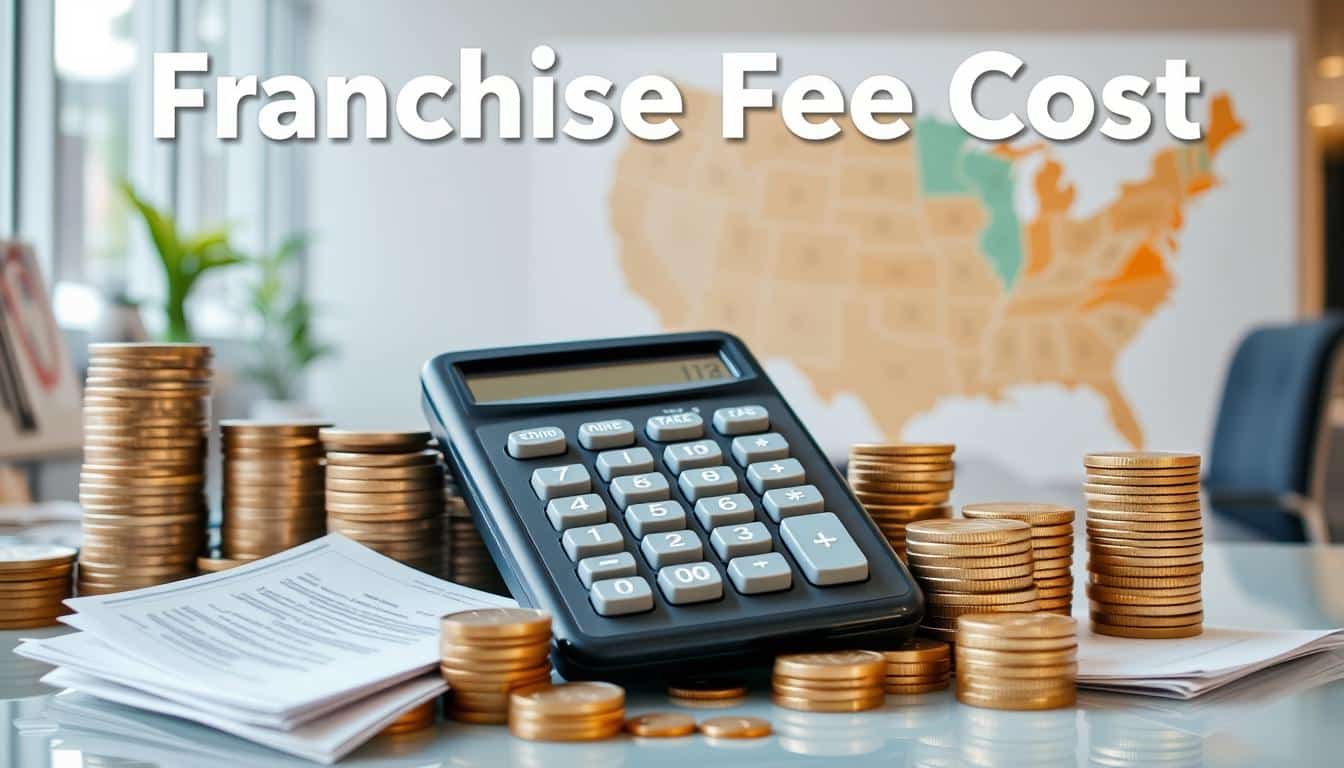Ever wondered what’s behind the numbers of a franchise fee? It’s not just a payment; it’s the door to a successful business plan. Franchise costs can range from $20,000 to $50,000. Knowing all about these costs is key for anyone thinking of starting a franchise.
There are more than just the initial fees. You’ll also face royalties and other costs. Understanding these can help entrepreneurs make better choices.
Exploring what a franchise fee includes can help you succeed. Knowing the financial and legal sides of these fees is important. It can lead to smarter investments and a better business journey.
Key Takeaways
- The typical franchise fee ranges from $20,000 to $50,000 in the US.
- Franchise fees are a one-time upfront payment required to join the franchise.
- Ongoing royalty fees can vary from 4% to 12% of sales and are separate from franchise fees.
- Veterans may qualify for discounts on franchise fees through special programs.
- New franchises often offer lower fees to attract new business owners.
- Franchise fees provide access to extensive training, operational manuals, and ongoing support.
What is a Franchise Fee?
A franchise fee is a key part of starting a franchise. It’s a one-time payment that lets you use an established brand. The cost varies, from $20,000 to $50,000, based on the brand’s reputation.
This fee gives you access to a tested business model. You also get training and ongoing support from the franchisor.
Definition of Franchise Fee
The franchise fee opens the door to using the franchisor’s brand and strategies. It’s a big investment for immediate credibility and market access. Knowing about the franchise fee is essential for those starting a franchise.
Common Purpose of Franchise Fees
Franchise fees do more than just give you access to the brand. They let you use the franchisor’s trademarks and marketing. This ensures a consistent brand experience.
These fees help with brand recognition and provide key resources for new owners. They also cover initial costs like equipment, inventory, and insurance.
Types of Franchise Fees
Franchise fees come in different types that affect how much you’ll pay to join a franchise. Knowing about these fees helps you understand the total cost of becoming a franchisee.
Initial Franchise Fee
The initial franchise fee is a one-time payment when you sign the agreement. It usually costs between $20,000 and $50,000, depending on the brand. For example, Creative Colors International (CCI) asks for $49,500 upfront. This fee lets you use the franchisor’s brand and business model.
Ongoing Royalty Fees
Ongoing royalty fees are regular payments based on your sales. They usually range from 5% to 9%. CCI charges 7.5% of your sales. These fees help you use the franchisor’s successful methods and get ongoing support.
Marketing Fees
Marketing fees are a percentage of your sales, used for ads and local marketing. CCI charges 1% of your sales for marketing. These fees are key for keeping your brand visible and attracting customers, helping your business grow.
Factors Influencing Franchise Fee Amounts
When looking at franchise opportunities, several important factors affect the fee. Knowing these can help future franchisees make smart choices. They can better understand the investment they’re considering.
Industry Type
The type of industry a franchise is in greatly affects the fee. Big sectors like fast food usually cost more. This is because they have strong brands and systems built over time.
For example, a fast-food chain like McDonald’s can ask for between $45,000 and $1.5 million. This shows the high costs of being in the food service industry.
Brand Reputation
Brand reputation can be both good and bad when it comes to fees. Famous brands often charge more because they have loyal customers. They also seem more valuable to people.
This makes it worth it for some to invest in well-known brands. It’s a key reason to think about the long-term benefits of a strong brand.
Location Considerations
Where a franchise is located also matters a lot. Economic conditions and demand vary by area. This can mean higher fees in some places than others.
For instance, franchises in big cities might cost more than those in small towns. This is because of different expenses and demand levels. So, it’s important for those interested to study the market well.
Average Franchise Fee Costs in the US
Understanding the average franchise fee costs in the United States is key for those thinking about owning a franchise. The costs vary a lot, depending on the brand’s prestige, the industry, and where it’s located. It’s important for future franchise owners to know the national averages and the differences between high and low-end franchises.
National Averages
The average franchise fee in the U.S. usually ranges from $25,000 to $50,000. This range shows the wide variety of franchise opportunities out there. For example, Cruise Planners starts at $10,995, while some well-known brands can cost over $100,000. Knowing these averages helps future owners compare different franchises.
High vs. Low-End Franchises
Franchise fees can vary a lot. High-end franchises like Club Pilates and BrightStar Care often cost more than $100,000 and have higher ongoing fees. On the other hand, lower-end franchises, such as Vanguard Cleaning Systems, can start at $5,500. The cost depends on the level of support and brand recognition offered. This knowledge helps future franchisees find a business that fits their budget.
Understanding the Value of Franchise Fees
Franchise fees are a big decision for those thinking of starting a franchise. They offer a chance to see the value of franchise fees by looking at the return on investment (ROI) and the access to established business models. Buying into a franchise means stepping into a system that has already proven itself. This can greatly reduce the risks of starting a new business.
Return on Investment
The link between franchise fees and ROI is key. A smart investment can lead to big returns. For instance, if a franchise costs $400,000 and makes $100,000 a year, adding a $20,000 transfer fee lowers the ROI to about 23.8%. It’s important for franchisees to look at all costs, including fees, to make sure their investment fits their financial goals.
One common mistake is not fully understanding these costs. This can lead to financial surprises. It’s vital to get a clear picture of all costs involved.
Access to Established Business Models
Buying a franchise gives you access to the power of established business models. The fees you pay cover things like brand recognition, operational support, and successful strategies. These fees usually include initial training, marketing help, and ongoing support. This support can help you grow faster and reach a break-even point sooner.
This is a big plus for anyone considering a franchise. For more information on franchise fees and their effects, check out this useful resource.
Legal Considerations of Franchise Fees
For those thinking about becoming a franchisee, knowing the law is key. The Franchise Disclosure Document (FDD) is very important. It lists all the money you’ll need to pay, including the initial fee and ongoing costs.
Before you sign anything, make sure to read the FDD carefully. It has 23 key points to help you understand what you’re getting into.
The Franchise Disclosure Document (FDD)
The FDD must be given at least 14 days before you sign the agreement or pay any money. This is a big part of the legal stuff you need to know. Each state has its own rules for FDDs, which can change how you run your franchise.
Places like California, New York, and Texas have their own rules. These rules can really affect how you do business.
State Requirements
State laws play a big role in franchise agreements. Knowing these laws helps you understand your duties. For example, there are rules about how much you have to pay and what kinds of franchises you can have.
It’s important to know these rules. They help you prepare for the money you’ll need to spend.

Financing Options for Franchise Fees
Understanding financing options is key when thinking about joining a franchise. There are many ways to fund a franchise, and it’s important to explore them all. This helps find the right fit for your financial situation and goals.
Traditional Loans
Traditional loans are a common way to finance a franchise. Banks and credit unions offer these loans. They usually need good credit, a strong business plan, and some business experience.
The Small Business Administration (SBA) has special loans for franchises. These loans have long repayment terms and low interest rates. Some lenders, like Wells Fargo and U.S. Bank, have programs for well-known franchises. This makes getting a loan easier.
Alternative Financing Solutions
If you’re looking for different ways to fund your franchise, consider alternative options. Online lenders like iBusiness Funding and OnDeck offer fast funding. They can approve applications in days.
These loans have shorter repayment terms and higher interest rates. But, they’re good for those who need money quickly. You can also use ROBS (Rollover for Business Startups) to use retirement funds without penalties. Equipment leasing and home equity loans are other options to think about.
Common Mistakes to Avoid with Franchise Fees
When looking into franchise opportunities, it’s key to know common mistakes. These can harm your financial future. One big mistake is underestimating the total costs of owning a franchise.
Underestimating Total Costs
Many people only look at the initial franchise fee, which is about $45,000. But they forget about other big expenses. These include building costs, equipment, initial stock, and cash for the business. These can add up to over $400,000.
Not planning for these extra costs can cause financial trouble. It can also make running the business hard.
Ignoring Ongoing Fees
Also, don’t ignore the ongoing fees. These include royalties and marketing fees. They help keep the franchise’s brand strong. It’s important to think about these fees before joining a franchise.
Those who want to do well should look for information on common mistakes. This helps understand all the financial responsibilities.

Conclusion: Making Informed Decisions About Franchise Fees
When thinking about owning a franchise in the United States, it’s key to understand the fees involved. There are different types of fees, like the initial fee, ongoing royalty fees, and extra costs. These can greatly affect whether a franchise is a good choice.
For example, the initial fee for a well-known franchise like McDonald’s can be very high, sometimes over $200,000. But, other franchises, mainly in cheaper sectors, might only need £30,000 to £40,000.
Before deciding, it’s important to look at your finances carefully. NatWest suggests doubling your savings to see if you can afford a franchise. This helps you figure out which franchises fit your budget.
It’s also vital to know how royalty fees, which are usually around 5% of sales, work. These fees help keep the brand strong and visible. This knowledge is key to keeping your finances healthy.
In the end, understanding your financing options and the common financial challenges can help you succeed in franchising. By considering all costs and their possible returns, you can make a smart choice for your business.





